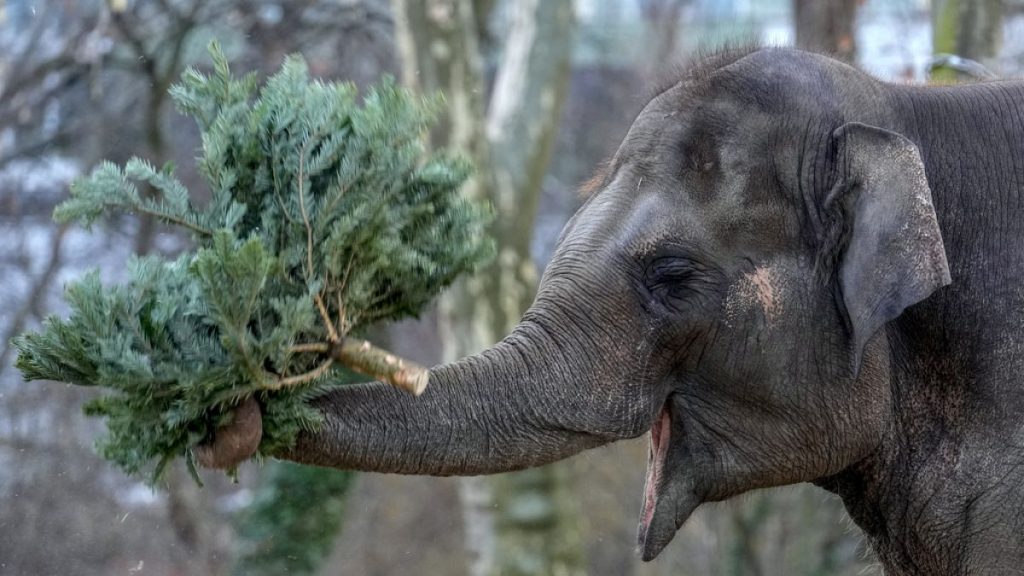The post describes a heartwarming initiative undertaken by a zoo, utilizing unsold Christmas trees to enrich the environment and provide novel stimulation for its animal inhabitants. This practice involves collecting fresh, unsold Christmas trees from pre-approved vendors and introducing them into the enclosures of select animals. This year, the program was expanded to include giraffes, marking the first time these majestic creatures have had the opportunity to interact with the festive evergreens. The varied reactions of the giraffes, with Max displaying enthusiastic delight and Mugambi expressing a more cautious curiosity, highlight the individuality of animal personalities and their responses to novel stimuli.
This thoughtful utilization of unsold Christmas trees offers multiple benefits to the animals. Firstly, it provides a form of environmental enrichment, diversifying their surroundings and stimulating their natural curiosity and exploratory behaviors. Animals in captivity often lack the varied stimuli present in their natural habitats, and the introduction of novel objects like Christmas trees can help alleviate the monotony and boredom of a confined environment. The trees offer new textures, scents, and even potential foraging opportunities, promoting physical activity and mental stimulation. Secondly, the trees can serve as a natural form of olfactory and tactile enrichment. The distinct scent of pine needles can be stimulating and intriguing for the animals, while the branches and needles provide interesting textures to explore. This can be particularly beneficial for animals with heightened senses of smell or touch.
The zoo’s careful selection of tree vendors is a crucial aspect of this initiative. By partnering with specific sellers, the zoo ensures the trees are free from harmful chemicals, pesticides, or fire retardants that could pose a risk to animal health. Additionally, the collection process from selected vendors guarantees that all decorations, tinsel, and ornaments have been completely removed, eliminating the potential for ingestion or entanglement. This stringent selection process underscores the zoo’s commitment to prioritizing animal welfare and safety in all aspects of their care.
The introduction of the Christmas trees to the giraffe enclosure marks an exciting expansion of this program. Giraffes, known for their gentle nature and towering height, are herbivores with a diet primarily consisting of leaves and twigs. The Christmas trees, therefore, offer a unique and potentially palatable addition to their usual fare. Max’s immediate acceptance of the tree suggests a pleasant surprise and perhaps a welcome variation in texture and taste. Mugambi’s more hesitant approach, however, is equally valid and reflects the natural caution some animals exhibit when encountering something unfamiliar. This cautious behavior allows animals to assess potential risks before fully engaging with a new object or food source.
The zoo’s policy of not accepting Christmas trees from the general public is also rooted in a commitment to animal safety. While well-intentioned, publicly donated trees carry significant risks. They may have been treated with chemicals or adorned with decorations that could be harmful if ingested or entangled. The zoo’s controlled sourcing from pre-approved vendors minimizes these risks and ensures the trees meet the highest standards of safety for their animal residents. This approach allows the zoo to confidently provide this enrichment experience while safeguarding the well-being of its animals.
In conclusion, the zoo’s initiative of repurposing unsold Christmas trees into environmental enrichment for its animals demonstrates a creative and responsible approach to animal welfare. By carefully sourcing trees from selected vendors, the zoo ensures the safety and suitability of the trees for their inhabitants. The diverse reactions of the giraffes to their first Christmas tree encounter highlight the individual personalities and behaviors within the animal kingdom. This practice not only provides stimulating and enriching experiences for the animals but also aligns with broader efforts toward sustainability and resourcefulness, finding a meaningful second life for unsold Christmas trees while contributing to the well-being of the animals in their care. This program serves as a testament to the innovative ways zoos are continually striving to enhance the lives of the animals entrusted to them, creating enriching experiences that promote physical and mental well-being.














